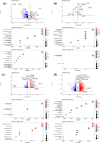Transcriptomic profiling of scleroderma monocytes reveals links with cardiovascular complications, implicating Notch and interferon pathways
- PMID: 40735732
- PMCID: PMC12301231
- DOI: 10.1177/23971983251356123
Transcriptomic profiling of scleroderma monocytes reveals links with cardiovascular complications, implicating Notch and interferon pathways
Abstract
Objectives: Recent research has highlighted the critical role of monocytes and macrophages in driving both inflammatory and fibrotic processes in systemic sclerosis. This study seeks to elucidate the gene expression profiles of systemic sclerosis monocytes and their potential links to disease complications, with the ultimate goal of uncovering novel therapeutic targets.
Methods: A total of 48 systemic sclerosis patients and 15 controls were recruited and monocytes were isolated using CD14+ magnetic beads. Total RNA was extracted and bulk RNA-seq analysis was performed. Differential gene expression followed by unsupervised hierarchical clustering and pathway analysis was conducted, and correlations with clinical features were analyzed. Interferon signature score (IFN6) was calculated using the log transformed values of six genes (IFIT3, IFIT2, MX1, IFIH1, STAT2, and NCF1).
Results: We identified four distinct patient subgroups, relative to normal, two with inflammatory and two with non-inflammatory gene profiles. The inflammatory subgroups exhibited high expression of interferon-related genes and included all systemic sclerosis patients with pulmonary hypertension and most with cardiac involvement. In these patients, IFN6 was markedly elevated and showed a significant correlation with global longitudinal strain (GLS; r = -0.5, p = 0.006), a key indicator of cardiac function. Furthermore, pathway analysis identified an enrichment of the Notch signaling pathway among genes whose overexpression correlated with impaired global longitudinal strain.
Conclusion: These findings unveil a potential new mechanistic link between interferon activity, Notch signaling, and cardiac complications in systemic sclerosis, offering new insights into disease pathogenesis and potential therapeutic targets.
Keywords: Scleroderma; cardiovascular complications; disease characteristics; gene expression; monocytes.
© The Author(s) 2025.
Conflict of interest statement
The author(s) declared the following potential conflicts of interest with respect to the research, authorship, and/or publication of this article: J.K.L. received research support from United Therapeutics within the past 3 years. R.L. reports research grants from Bristol Myers Squibb, Formation, Moderna, Regeneron and Pfizer; serves/served as consultant for AbbVie, Mediar, Bristol Myers Squibb, Formation, Thirona Bio, Sanofi, Boehringer-Ingelheim, Merck, Genentech/Roche, EMD Serono, Morphic, Third Rock Ventures, Bain Capital and Zag Bio; serves on independent data safety monitoring committees for Advarra/GSK and Genentech; holds stock in Thirona Bio Inc; and is president and stockholder of Modumac Therapeutics Inc. A.M.B. serves as a consultant for Mediar Therapeutics.
Figures





References
Grants and funding
LinkOut - more resources
Full Text Sources
Research Materials
Miscellaneous
